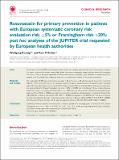| dc.contributor.author | Koenig, Wolfgang | |
| dc.contributor.author | Ridker, Paul M. | |
| dc.date.accessioned | 2011-05-15T21:47:31Z | |
| dc.date.issued | 2010 | |
| dc.identifier.citation | Koenig, Wolfgang and Paul M. Ridker. 2011. Rosuvastatin for primary prevention in patients with European systematic coronary risk evaluation risk ≥5% or Framingham risk >20%: post hoc analyses of the JUPITER trial requested by European health authorities. European Heart Journal 32(1): 75-83. | en_US |
| dc.identifier.issn | 0195-668X | en_US |
| dc.identifier.uri | http://nrs.harvard.edu/urn-3:HUL.InstRepos:4889505 | |
| dc.description.abstract | Aims: On the basis of the JUPITER trial, European health authorities recently approved the use of rosuvastatin to reduce first major cardiovascular events among ‘high' global risk primary prevention patients defined either by Framingham risk score >20% or European systematic coronary risk evaluation (SCORE) ≥5%. However, as these are post hoc analyses, data describing these subgroups have not previously been available to the clinical community. Methods and results: We randomized 17 802 apparently healthy men aged ≥50 and women ≥60 with low-density lipoprotein cholesterol (LDL-C) <3.4 mmol/L, who were at an increased vascular risk due to elevated levels of C-reactive protein measured with a high-sensitivity (hs) assay to rosuvastatin 20 mg daily or placebo. Patients with high global cardiovascular risk at baseline were identified by 10-year Framingham risk score >20% or SCORE risk ≥5%. During 1.8-year median follow-up (maximum 5 years) of patients with Framingham risk >20%, the rate of myocardial infarction/stroke/cardiovascular death was 9.4 and 18.2 per 1000 person-years in rosuvastatin and placebo-allocated patients, respectively [hazard ratio (HR): 0.50, 95% confidence interval (CI): 0.27–0.93, P = 0.028]. Among patients with SCORE risk ≥5%, the corresponding rates were 6.9 and 12.0 using a model extrapolating risk for age ≥65 years (HR: 0.57, 95% CI: 0.43–0.78, P = 0.0003) and rates were 5.9 and 12.7 when risk for age was capped at 65 years (HR: 0.47, 95% CI: 0.32–0.68, P < 0.0001). Conclusion: In primary prevention patients with elevated hs C-reactive protein who have high global cardiovascular risk (10-year Framingham risk score >20% or SCORE risk ≥5%), but LDL-C levels not requiring pharmacologic treatment, rosuvastatin 20 mg significantly reduced major cardiovascular events. ClinicalTrial.gov Identifier: NCT00239681 | en_US |
| dc.language.iso | en_US | en_US |
| dc.publisher | Oxford University Press | en_US |
| dc.relation.isversionof | doi:10.1093/eurheartj/ehq370 | en_US |
| dc.relation.hasversion | http://www.ncbi.nlm.nih.gov/pmc/articles/PMC3013199/pdf/ | en_US |
| dash.license | LAA | |
| dc.subject | rosuvastatin | en_US |
| dc.subject | coronary heart disease | en_US |
| dc.subject | C-reactive protein | en_US |
| dc.subject | high risk | en_US |
| dc.title | Rosuvastatin for primary prevention in patients with European systematic coronary risk evaluation risk ≥5% or Framingham risk >20%: post hoc analyses of the JUPITER trial requested by European health authorities | en_US |
| dc.type | Journal Article | en_US |
| dc.description.version | Version of Record | en_US |
| dc.relation.journal | European Heart Journal | en_US |
| dash.depositing.author | Ridker, Paul M. | |
| dc.date.available | 2011-05-15T21:47:31Z | |
| dash.affiliation.other | SPH^Epidemiology | en_US |
| dash.affiliation.other | HMS^Medicine-Brigham and Women's Hospital | en_US |
| dc.identifier.doi | 10.1093/eurheartj/ehq370 | * |
| dash.contributor.affiliated | Ridker, Paul | |
| dc.identifier.orcid | 0000-0003-1249-4522 | |


